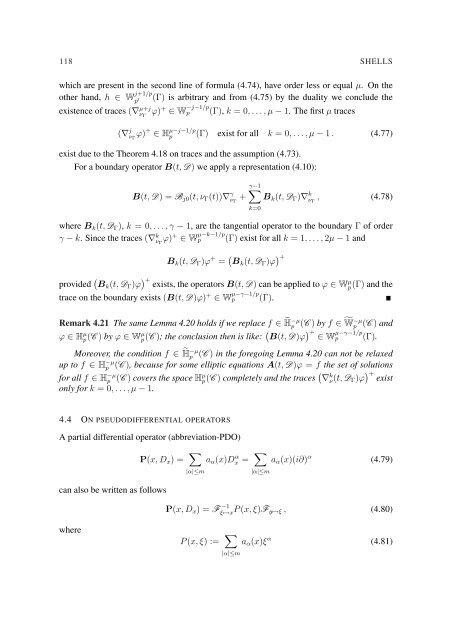EQUATIONS OF ELASTIC HYPERSURFACES
EQUATIONS OF ELASTIC HYPERSURFACES
EQUATIONS OF ELASTIC HYPERSURFACES
Create successful ePaper yourself
Turn your PDF publications into a flip-book with our unique Google optimized e-Paper software.
118 SHELLS<br />
which are present in the second line of formula (4.74), have order less or equal µ. On the<br />
other hand, h ∈ W j+1/p<br />
p<br />
(Γ) is arbitrary and from (4.75) by the duality we conclude the<br />
′<br />
existence of traces (∇ µ+j<br />
ν Γ<br />
ϕ) + ∈ W −j−1/p<br />
p (Γ), k = 0, . . . , µ − 1. The first µ traces<br />
(∇ j ν Γ<br />
ϕ) + ∈ H µ−j−1/p<br />
p (Γ) exist for all k = 0, . . . , µ − 1 . (4.77)<br />
exist due to the Theorem 4.18 on traces and the assumption (4.73).<br />
For a boundary operator B(t, D) we apply a representation (4.10):<br />
γ−1<br />
∑<br />
B(t, D) = B j0 (t, ν Γ (t))∇ γ ν Γ<br />
+ B k (t, D Γ )∇ k ν Γ<br />
, (4.78)<br />
where B k (t, D Γ ), k = 0, . . . , γ − 1, are the tangential operator to the boundary Γ of order<br />
γ − k. Since the traces (∇ k ν Γ<br />
ϕ) + ∈ W µ−k−1/p<br />
p (Γ) exist for all k = 1, . . . , 2µ − 1 and<br />
k=0<br />
B k (t, D Γ )ϕ + = ( B k (t, D Γ )ϕ ) +<br />
provided ( B k (t, D Γ )ϕ ) +<br />
exists, the operators B(t, D) can be applied to ϕ ∈ W<br />
µ<br />
p (Γ) and the<br />
trace on the boundary exists (B(t, D)ϕ) + ∈ W µ−γ−1/p<br />
p (Γ).<br />
−µ<br />
Remark 4.21 The same Lemma 4.20 holds if we replace f ∈ p (C ) by f ∈ ˜W p (C ) and<br />
ϕ ∈ H µ p(C ) by ϕ ∈ W µ p(C ); the conclusion then is like: ( B(t, D)ϕ ) + µ−γ−1/p ∈ W p (Γ).<br />
˜H<br />
−µ<br />
p<br />
Moreover, the condition f ∈ (C ) in the foregoing Lemma 4.20 can not be relaxed<br />
(C ), because for some elliptic equations A(t, D)ϕ = f the set of solutions<br />
up to f ∈ H −µ<br />
p<br />
for all f ∈ H −µ<br />
p<br />
only for k = 0, . . . , µ − 1.<br />
˜H<br />
−µ<br />
(C ) covers the space H µ p(C ) completely and the traces ( ∇ k ν(t, D Γ )ϕ ) +<br />
exist<br />
4.4 ON PSEUDODIFFERENTIAL OPERATORS<br />
A partial differential operator (abbreviation-PDO)<br />
can also be written as follows<br />
P(x, D x ) = ∑<br />
|α|≤m<br />
a α (x)D α x = ∑<br />
|α|≤m<br />
a α (x)(i∂) α (4.79)<br />
P(x, D x ) = F −1<br />
ξ↦→x P (x, ξ)F y↦→ξ , (4.80)<br />
where<br />
P (x, ξ) := ∑<br />
a α (x)ξ α (4.81)<br />
|α|≤m

















